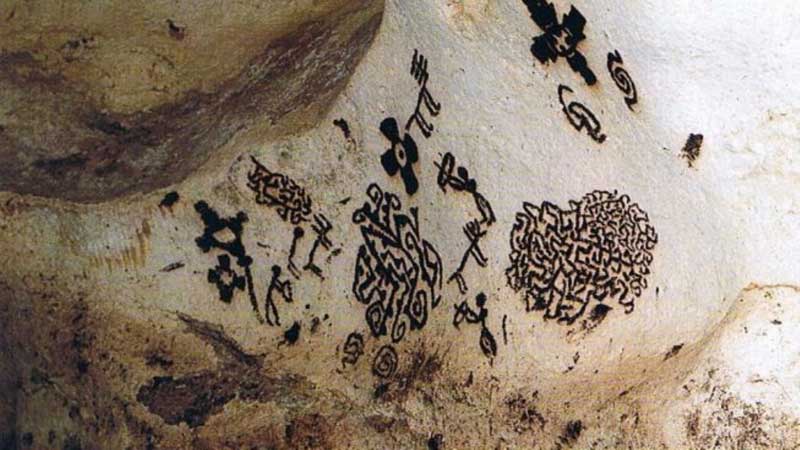
Unknown before its discovery during an ongoing routine exploration of the local territory on 1 February 1970 by a team of Speleologists, Grotta dei Cervi or the Deer Cave, a natural cave at the Salento coast near the town of Porto Badisco in Italy, came to immediate international attention for its impressive, innovative and enigmatic complex galleries of prehistoric parietal wall paintings.
Initially, it was named Grotta di Enea or the cave of Aeneas, referring to Virgil’s Aeneid, in which the Trojan hero Aeneas first landed in Italy, precisely in Porto Badisco. However, access to the cave was soon closed to the public and restricted only to the authorised personnel and researchers, for the safe preservation of paintings in the original environmental conditions.

Grotta dei Cervi is specifically located in Porto Badisco, about 10 km south of the municipality of Otranto, in the province of Lecce in Italy. The cave has two entries and the main entrance is located at about 91 to 98 feet (28 to 30 m) above sea level, on the promontory of the inlet of Porto Badisco and its maximum depth is about 85 feet (26 m) below sea level.
The cave consists of three main corridors or galleries, covering a combined length of more than 4900 feet (1500 m) interior of the white karst surface. The walls of the three galleries of the Grotto are covered with around 3000 individual pictograms, from the smallest of about 2 cm to the largest of about 75 cm, concentrated in groups in the three galleries, over a total length of 2000 feet (600 m), executed in black and red.

For pigments and adhesives, the artists used organic and mineral materials found on the site. While subfossil bat guano was used for the most part painted in black, red was lesser used with the use of ferruginous red ocher, obtained with a mixture of animal fats and mineral colours. The paintings of the Grotta dei Cervi are attributed to the late Neolithic period, the final division of the Stone Age, which is 20,000 years more recent than the well known Paleolithic or Old Stone Age cave paintings found in Lascaux in France and Altamira in Spain.
The artwork composition and implementation of the pictograms of the Grotta dei Cervi suggest that those Neolithic artists belonged to the greater European, Mediterranean and Trans-Alpine pan-culture, that lived at the margins of agriculture. In addition, they were also endowed with a common set of ideas and had an inherent understanding of surreal and metaphoric concepts.

The paintings in Grotta dei Cervi include a few realistic elements, like female figures, scenes of tribal dances and a scene of a deer hunter assisted by two dogs, the motif that gave the cave its name. They also include humanoid and theriomorphic beings resembling ghosts, bizarre spirits and spectres, apart from many other abstract concentric circles, spirals, crosses, stars, parallel lines, single and S-shaped mirrors, labyrinths, serpentines and chains. Small handprints on a ceiling suggest prints of female or child hands due to their small size. In addition to the paintings, a considerable set of ceramics was found in the cave, especially in the front part of the cave, which includes various potteries, bowls and vases.

The first corridor of Grotta dei Cervi, directly accessible from the main entrance to the west, is about 660 feet (200 m) long and contains a puddle fed by dripping water. The section was used as a storage site for bat guano, collected from different sections of the cave complex. The corridor, containing two human skeletons without heads on the northern end, splits into two branches and is connected to the second corridor by a narrow passage. The second corridor, which is rich in painting, widens towards the end and leads to two successive rooms and the first room contains one of the Fish Women having two fins instead of feet. However, the most controversial painting of the site is a female figure in the shape of an S, with breasts attached directly to the neck, along with a triangular head surmounted by a crown with seven rays. The second room of the second corridor, with lower ceiling, is circular and contains seven pictorial groups with a few scattered graphemes. The third corridor, around 200 m (660 ft) long, is accessible from the second hall, called Red Hall, through a very low opening and following that, the vault is lowered considerably, making the cave completely inaccessible.

The pictograms in Grotta dei Cervi are believed to be of a high degree of cultural and historical significance with exceptional artistic quality. In 2006, the Ministry of Cultural Heritage and Activities of Aplia submitted a proposal for inducting the cave into the list of UNESCO World Heritage Sites and received official notice and recognition as Karstic Caves in prehistoric Apilia, which also include Grotta Romanelli Castro and Grotta delle Veneri.